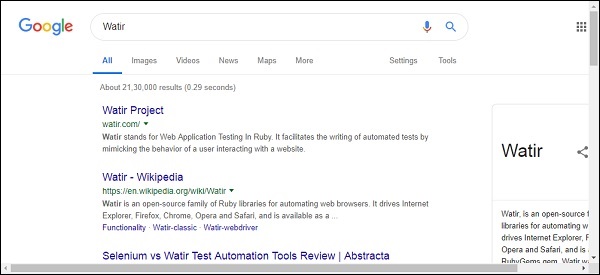
- Watir - Home
- Watir - Overview
- Watir - Introduction
- Watir - Environment Setup
- Watir - Installing Drivers for Browsers
- Watir - Working with Browsers
- Watir - Web Elements
- Watir - Locating Web Elements
- Watir - Working with Iframes
- Watir - Automatic Waits
- Watir - Headless Testing
- Watir - Mobile Testing
- Watir - Capturing Screenshots
- Watir - Page Objects
- Watir - Page Performance
- Watir - Cookies
- Watir - Proxies
- Watir - Alerts
- Watir - Downloads
- Watir - Browser Windows
- Watir Useful Resources
- Watir - Quick Guide
- Watir - Useful Resources
- Watir - Discussion
Watir - Quick Guide
Watir - Overview
Watir (Web Application Testing in Ruby), pronounced as "Water" is an open source tool developed using Ruby which helps in automating web application that suits applications developed in any programming language. The browsers supported for Watir installation Internet Explorer, Firefox, Chrome, Safari, and Edge. Watir is available as Rubygems for installation.
Watir will connect to the browser given and follows up the instructions of opening the URL, clicking on the button, entering data inside a textbox just as any real person will do. Watir is most commonly used for its browser support with testing frameworks like RSpec, Cucumber, etc.
Features of Watir
Watir is rich in features, as discussed below −
Location web elements − There are different ways you can locate web-elements rendered inside the browser. The ones mostly used are id, class, tag name, custom attributes, label etc.
Taking Screenshots − Watir allows you to take screenshot of the testing done as and when required. This helps to keep track of the intermediate testing.
Page Performance − You can easily measure page performance using the performance object which has properties like, performance.navigation, performance.timing, performance.memory and performance.timeOrigin. These details are obtained when you connect to the browser.
Page Objects − Page object in Watir will help us to reuse the code in the form of classes. Using this feature, we can automate our app without having to duplicate any code and also make it manageable.
Downloads − With Watir, it is easy to test file download for UI or website.
Alerts − Watir provides easy to use APIs to test alerts popup in your UI or website.
Headless Testing − Using headless testing, the details are obtained in the command line without having to open the browser. This helps to execute UI test cases at the command line.
Advantages of Using Watir
Watir offers the following advantages −
Watir is an open source tool and very easy to use.
Watir is developed in Ruby and any web application that works in a browser can be easily automated using watir.
All the latest browsers are supported in Watir making it easy for testing.
Watir has inbuilt libraries to test page-performance, alerts, iframes test, browser windows, take screenshots etc.
Disadvantages of Watir
Like any other software, Watir also has its limitations
Watir is supported only for Ruby test framework and it cannot be used with any other testing frameworks.
Mobile testing using Watir is not enhanced and desktop browsers are mimicked to behave like mobile browsers instead of acting as real time devices.
Watir - Introduction
Watir (Web Application Testing in Ruby) pronounced as Water is an open source tool developed using Ruby which helps in automating web application no matter which language the application is written. Watir comes with a rich set of APIs which helps us interact with the browser, locate page elements, take screenshots, work with alerts, file downloads, window.open popup windows, headless testing, etc.
The browsers supported are −
- Internet Explorer
- Firefox
- Chrome
- Safari
- Edge
Note − Watir is available as Rubygems gem for installation.
Using Watir webdriver, you can test your websites and UI applications. As Watir fully focuses on the browser related stuff, you can use Watir along with other test framework such as −
- RSpec
- Cucumber
The main testing code will be written using the test framework and interacting with the browser will be done with the help of Watir.
The flow of test framework along with Watir is as shown below −

RSpec or Cucumber are involved in test runner and test code. The details about the website or UI testing can be broken down into page object which will have reference to Watir, wherein it will get the page locators to be used for testing. Watir, along with its webdriver, helps in connecting to the browser and carry out the test automation.
Watir - Environment Setup
To work with Watir, we need to install the following −
- Install Ruby
- Install Watir
- Ruby Mine (IDE)
Since Watir is build using Ruby, we need to install Ruby and gem (package manager for Ruby).
Ruby Installation on Windows
To install Ruby on Windows, go to − https://rubyinstaller.org/downloads/
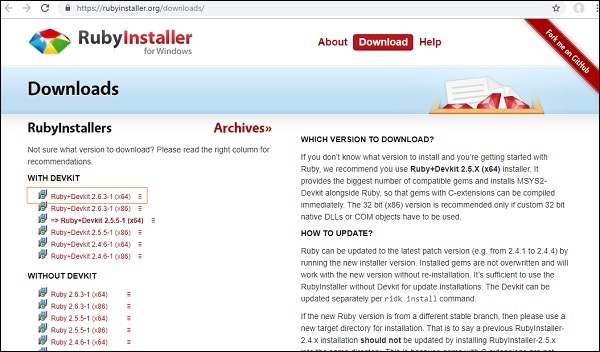
Install the ruby version based on your 32 or 64 bit operating system. Here we have installed the highlighted one as shown in the screenshot. Once you download it, follow the steps as prompted and install accordingly.
When you are done with the installation, check if ruby is installed by checking the version in command line as shown below −
C:\> ruby -v
If Ruby is successfully installed, you can see an output as shown below −

The version installed is 2.6.3. We have successfully installed Ruby on our system. Along with Ruby installation gem i.e. ruby package manager is also installed. You can check the version of gem installed as follows −

We are done with the installation of Ruby and Gem on windows.
Ruby Installation on Linux
For installing Ruby on Linux, run the following commands in your Linux terminal −
wget -O ruby-install-0.6.0.tar.gz https://github.com/postmodern/ruby-install/archive/v0.6.0.tar.gz tar -xzvf ruby-install-0.6.0.tar.gz cd ruby-install-0.6.0/ sudo make install ruby-install ruby 2.5.3
Ruby Installation for Mac
For installing Ruby on Linux, run below commands in your Mac terminal −
Install xcode
xcode-select --install
Install HomeBrew
/usr/bin/ruby -e "$(curl -fsSL https://raw.githubusercontent.com/Homebrew/install/master/install)"
Install rbenv
brew install rbenv rbenv init touch ~/.bash_profile echo 'eval "$(rbenv init -)"' >> ~/.bash_profile source ~/.bash_profile rbenv install 2.5.3 rbenv local 2.5.3
Installing Watir
The command to install watir is −
gem install watir
gem install watir
Then you can observe an output screen as shown below −
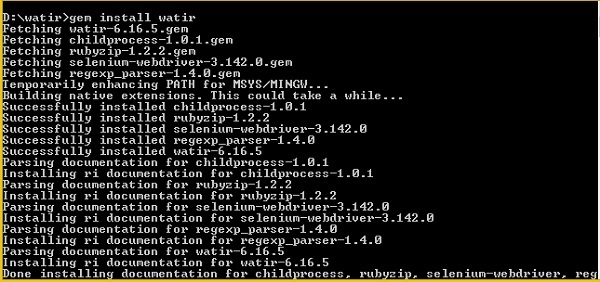
RubyMine IDE
We will use RubyMine IDE to write and execute our test cases. The official website for RubyMine IDE is www.jetbrains.com/ruby.
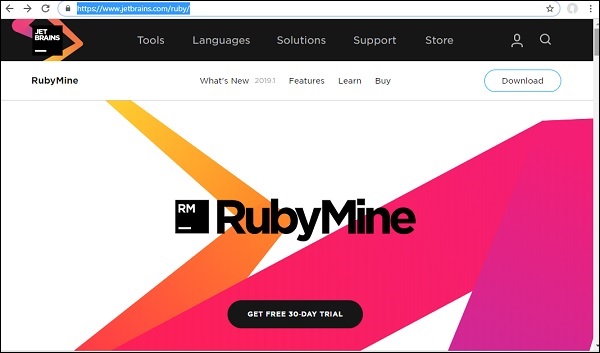
RubyMine is a paid IDE with a 30-day free trial. Click on free trial button to download. You may also use some other IDE of your choice to write the test-cases.
On-click of the free trial button, it will start downloading. Once the download is done, install it on your system.
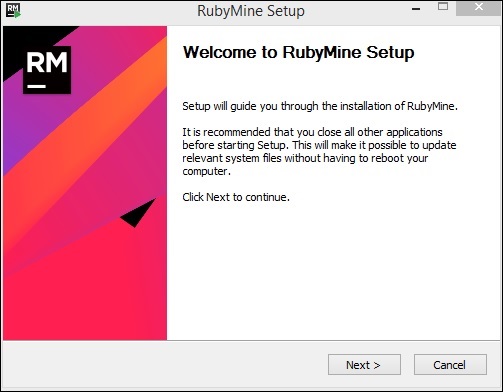
Click on Next and proceed with the installation. Once the installation is complete, open the IDE and it will ask you to create the project as shown below −

Click on Create New Project, we have entered the name of the project as Watir and here is the display in the IDE −

We will write our test-cases in watir/ folder and execute it.
Watir - Installing Drivers for Browsers
In this chapter, we are going to install browser drivers that we need to test our project using Watir. Prior to Watir 6, we had to include watir-webdriver to use the browser drivers. With the release of Watir 6, the watir-webdriver is available as part of Watir package and users do not have to add the watir-webdriver separately.
The browsers like Chrome, Firefox, and Safari are available by default and you do not have to add them externally. Incase while testing you get an issue that the driver for the browser is not available, you can always download them as instructed below.
We are going to install drivers for following browsers −
- Driver for Browsers - Chrome
- Driver for Browsers - Firefox
- Driver for Browsers - Edge
- Driver for Browsers - Internet Explorer
- Driver for Browsers - Safari
Driver for Browser - Chrome
To get the driver for chrome browser, go to − https://sites.google.com/a/chromium.org/chromedriver/downloads.
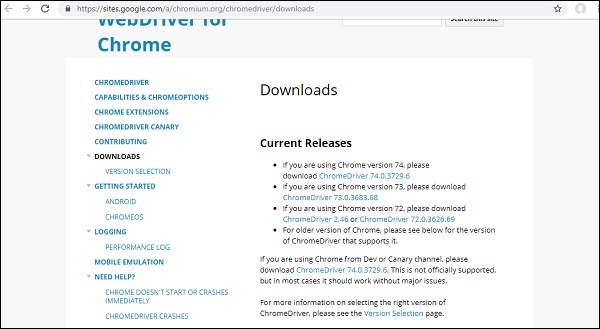
Check the version of your browser and accordingly download the Chrome driver. To check the version of your chrome browser, do as shown here −
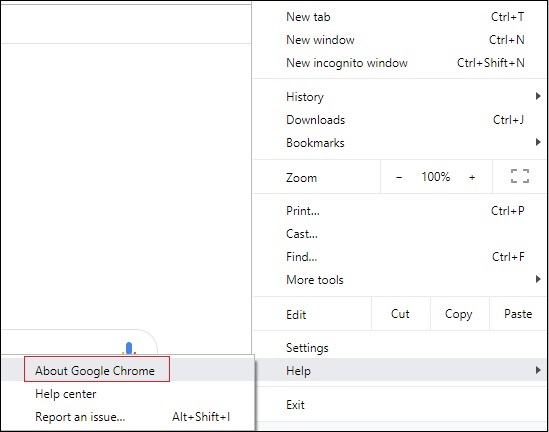
Click on About Google Chrome and it will give you the chrome version as shown below −

So our version is 74. So, download chrome driver version 74.
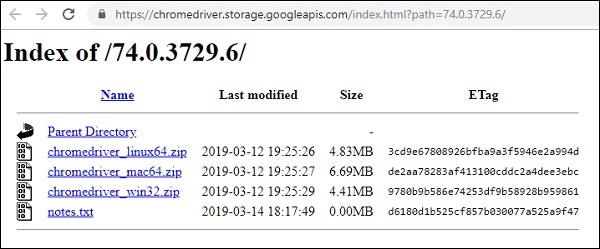
Next, download the chrome driver depending on your operating system. We will download chromedriver_win32.zip, it is meant for both 32-bit and 64-bit machines. In case you are planning to use the driver downloaded, add the location somewhere on your PATH variable.
Driver for Browser - Firefox
For Firefox driver, go to − https://github.com/mozilla/geckodriver/releases as shown in the screenshot below −
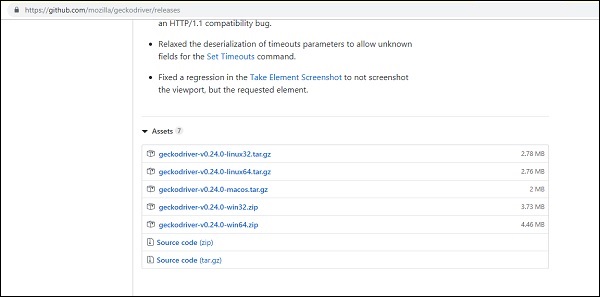
As per your operating system, download the driver as shown above. In case you planning to use the driver downloaded, add the location somewhere on your PATH variable.
Driver for Browser - Edge
For Firefox driver, go to − https://developer.microsoft.com/en-us/microsoft-edge/tools/webdriver/ as shown in the screenshot below −
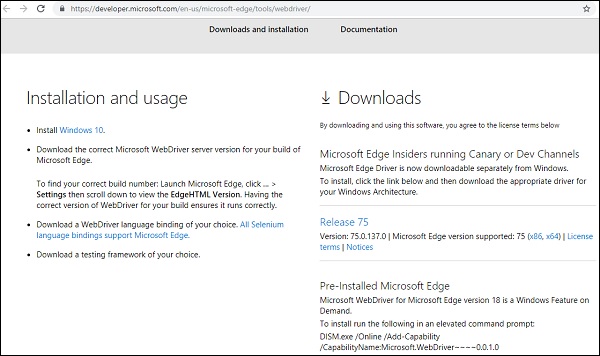
Click on the Version of Microsoft Edge you have as shown below −

Click on Release link and it will redirect you to −
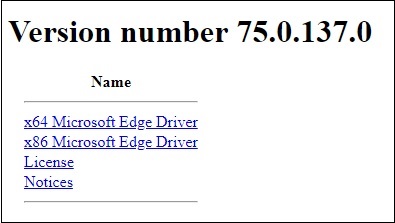
Here, you can find the download version available for windows. In case you are planning to use the driver downloaded, add the location somewhere on your PATH variable.
Driver for Browser - Internet Explorer
To install the driver for Internet Explorer go to − https://docs.seleniumhq.org/download/ as shown below −
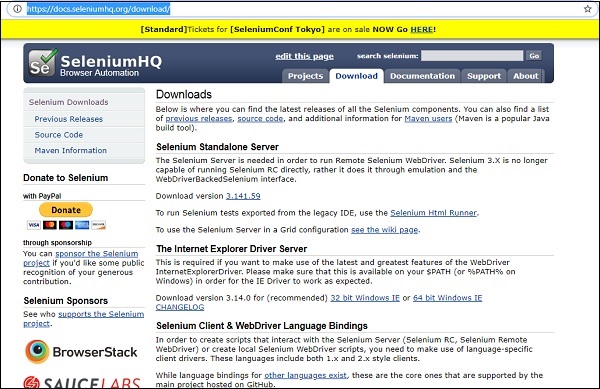
The details for the download section on IE are shown here −

As per your OS, download the 32 or 64 bit windows IE. Also add the location to you PATH variable to make use of the driver.
Drivers for Browsers - Safari
The drivers for safari are not required to be downloaded externally for safari version 10 onwards. They are downloaded along with the gem package while installing Watir.
Please note that drivers for Chrome, Firefox, Internet Explorer are also available when Watir is installed. But incase if you face any issues and need a specific version to be tested, you can download them as per your browser and update the location in PATH to make use of it in testing your application.
Watir - Working with Browsers
By default, Watir will open chrome browser in-case the browser name is not specified. The required browser drivers are installed along with Watir installation. In case you face any issues working with browsers, install the driver as shown in the Browsers drivers chapter and update the location in PATH variable.
In this chapter, we will understand how to open the browser using Watir.
Steps to Open a Browser using Watir
Open the IDE RubyMine and create a new file: test1.rb
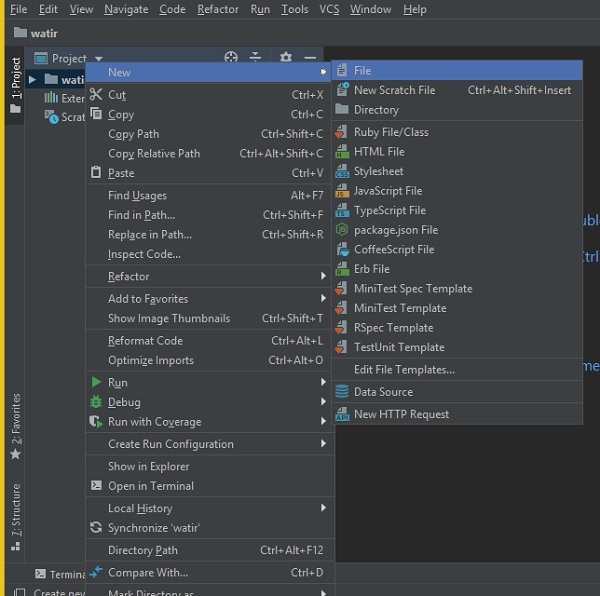
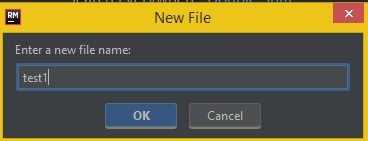
Select OK and click the file pattern as ruby as shown below −
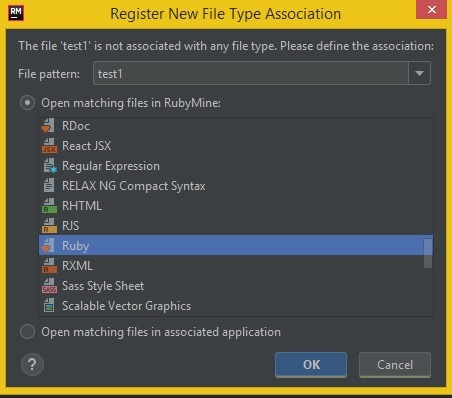
Click on OK to create the file.
Now we will write a simple code that will open the browser as shown below −
test1.rb
require 'watir' Watir::Browser.new
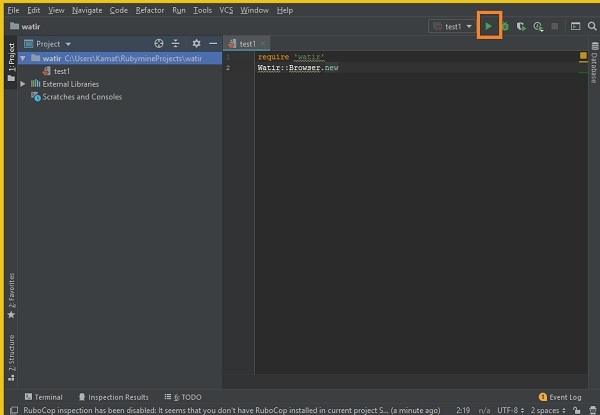
Click on the Run button that is highlighted in the IDE as shown above. On-click of Run, it will open browser as shown below −
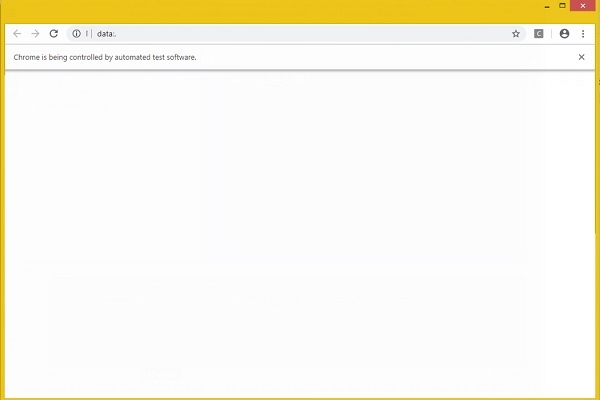
The browser will open and close automatically. Let us now add some more code to the test1.rb.
We can specify the name of the browser as shown below −
Example for Chrome
require 'watir' Watir::Browser.new :chrome
Now let us open a page-url in our test case.
Example
require 'watir'
browser = Watir::Browser.new
browser.goto("https://www.google.com")
Click on Run to see the output as shown below −
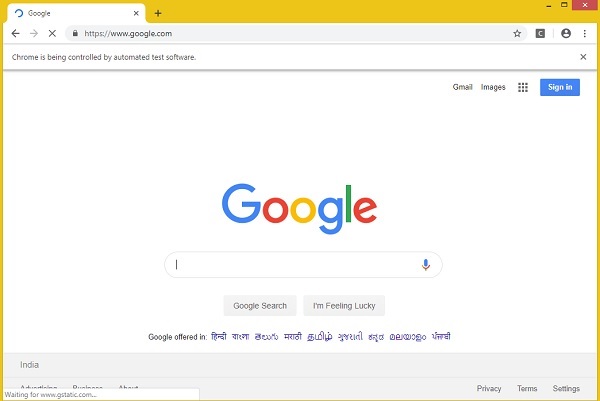
Similarly, you can open firefox, safari, Internet explorer browser.
Example for Firefox
require 'watir' Watir::Browser.new :firefox
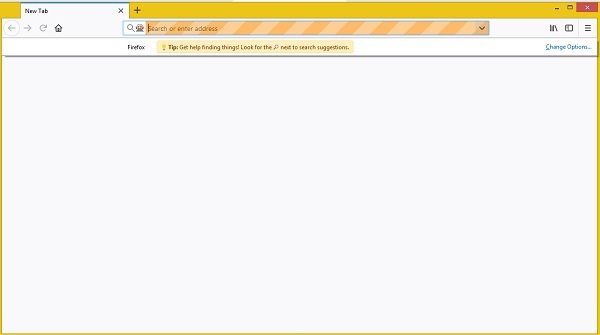
Example for Internet Explorer
Watir Code
require 'watir'
browser = Watir::Browser.new :ie
browser.goto("https://www.google.com")
When we run the code following error is displayed −
Unable to find IEDriverServer. Please download the server from (Selenium::WebDriver::Error::WebDriverError) http://selenium-release.storage.googleapis.com/index.html and place it somewhere on your PATH. More info at https://github.com/SeleniumHQ/selenium/wiki/InternetExplorerDriver.
This means that watir package does not have InternetExplorer Driver. We have downloaded the same from here − https://docs.seleniumhq.org/download/ and updated in PATH variable.
Now run it again to see the Internet Explorer browser opening as shown below −
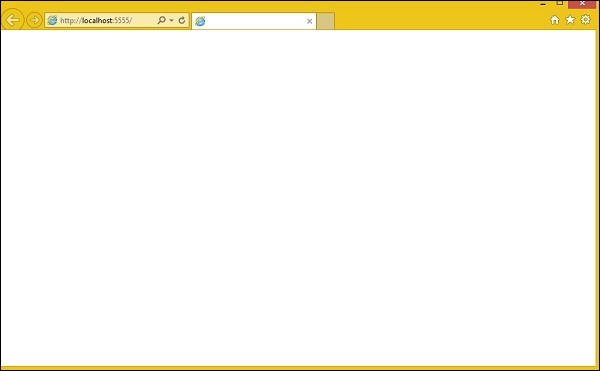
Watir code to open Safari Browser
require 'watir'
browser = Watir::Browser.new :safari
browser.goto("https://www.google.com")
Watir code to Microsoft Edge browser
require 'watir'
browser = Watir::Browser.new :edge
browser.goto("https://www.google.com")
Watir - Web Elements
In this chapter, we will discuss how to work with following in Watir −
- Working with Textboxes
- Working with Combos
- Working with Radio Buttons
- Working with Checkboxes
- Working with Buttons
- Working with Links
- Working with Divs
Working with Textboxes
Syntax
browser.text_field id: 'firstname' // will get the reference of the textbox
Here will try to understand how to work with textboxes on the UI.
Consider the page Textbox.html as shown below −
<html>
<head>
<title>Testing UI using Watir</title>
</head>
<body>
<script type = "text/javascript">
function wsentered() {
console.log("inside wsentered");
var firstname = document.getElementById("firstname");
if (firstname.value != "") {
document.getElementById("displayfirstname").innerHTML =
"The name entered is : " + firstname.value;
document.getElementById("displayfirstname").style.display = "";
}
}
</script>
<div id = "divfirstname">
Enter First Name :
<input type = "text" id = "firstname" name = "firstname" onchange = "wsentered()" />
</div>
<br/>
<br/>
<div style = "display:none;" id = "displayfirstname"></div>
</body>
</html>
The corresponding output is as shown below −
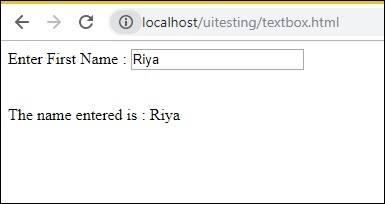
We are having a textbox, when you enter the name onchange event is fired and the name is displayed below.
Now let us write the code, wherein we will locate the textbox and enter the name and fire the onchange event.
Watir Code
require 'watir'
b = Watir::Browser.new :chrome
b.goto('http://localhost/uitesting/textbox.html')
t = b.text_field id: 'firstname'
t.exists?
t.set 'Riya Kapoor'
t.value
t.fire_event('onchange')
We are using chrome browser and given the pageurl as http://localhost/uitesting/textbox.html.
Using goto api browser will open the pageurl and we are going to find text_field having id: firstname. If that exists, we will set value as Riya Kapoor and will use fire_event api to fire the onchange event.
Now, let us run the code to display the output as shown below −
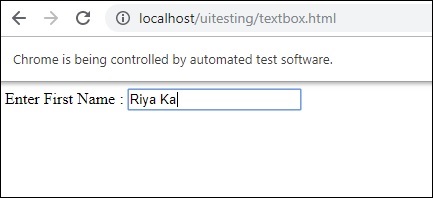
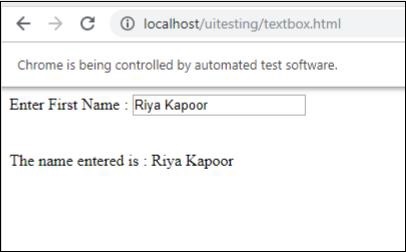
Working with Combos
Syntax
browser.select_list id: 'months' // will get the reference of the dropdown
The test page that we are going to test now is shown here −
<html>
<head>
<title>Dropdown</title>
</head>
<body>
<script type = "text/javascript">
function wsselected() {
var months = document.getElementById("months");
if (months.value != "") {
document.getElementById("displayselectedmonth").innerHTML =
"The month selected is : " + months.value;
document.getElementById("displayselectedmonth").style.display = "";
}
}
</script>
<form name = "myform" method = "POST">
<div>
Month is :
<select name = "months" id = "months" onchange = "wsselected()">
<option value = "">Select Month</option>
<option value = "Jan">January</option>
<option value = "Feb">February</option>
<option value = "Mar">March</option>
<option value = "Apr">April</option>
<option value = "May">May</option>
<option value = "Jun">June</option>
<option value = "Jul">July</option>
<option value = "Aug">August</option>
<option value = "Sept">September</option>
<option value = "Oct">October</option>
<option value = "Nov">November</option>
<option value = "Dec">December</option>
</select>
</div>
<br/>
<br/>
<div style = "display:none;" id = "displayselectedmonth">
</div>
</body>
</html>
Output
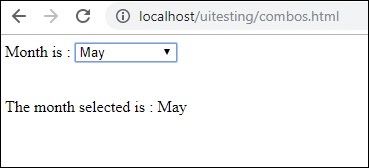
When you select month from the dropdown the same is displayed below.
Let us now test the same using Watir.
Watir Code for combo selection
require 'watir'
b = Watir::Browser.new :chrome
b.goto('http://localhost/uitesting/combos.html')
t = b.select_list id: 'months'
t.exists?
t.select 'September'
t.selected_options
t.fire_event('onchange')
To work with combos, you need to locate the select element using b.select_list api followed by the id of the dropdown. To select the value from the dropdown, you need to use t.select and the value you want.
The output on execution is as follows −
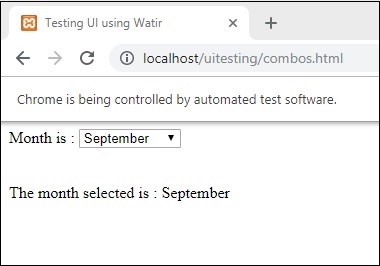
Working with Radio Buttons
Syntax
browser.radio value: 'female' // will get the reference of the radio button with value female
Here is a test page that we will use to work with radio buttons −
<html>
<head>
<title>Testing UI using Watir</title>
</head>
<body>
<form name = "myform" method = "POST">
<b>Select Gender?</b>
<div>
<br/>
<input type = "radio" name = "gender" value = "male" checked> Male
<br/>
<input type = "radio" name = "gender" value = "female"> Female
<br/>
</div>
</form>
</body>
</html>
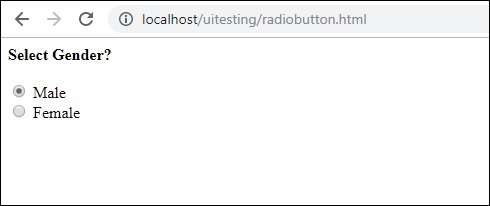
We will select radio button with value Female as shown in the Watir code −
require 'watir'
b = Watir::Browser.new
b.goto('http://localhost/uitesting/radiobutton.html')
t = b.radio value: 'female'
t.exists?
t.set
b.screenshot.save 'radiobutton.png'
To work with radio button, we need to tell the browser about the value we are selecting i.e. b.radio value:female
We are also taking the screenshot and saved that as radiobutton.png and the same is displayed below −
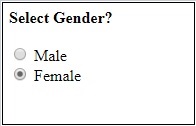
Working with Checkboxes
Syntax
browser. checkbox value: 'Train' // will get the reference of the checkbox with value Train
Here is the test page for checkboxes −
<html>
<head>
<title>Testing UI using Watir</title>
</head>
<body>
<form name = "myform" method = "POST">
<b>How would you like to travel?</b>
<div>
<br>
<input type = "checkbox" name = "option1" value = "Car"> Car<br>
<input type = "checkbox" name = "option2" value = "Bus"> Bus<br>
<input type = "checkbox" name = "option3" value = "Train"> Train<br>
<input type = "checkbox" name = "option4" value = "Air"> Airways<br>
<br>
</div>
</form>
</body>
</html>
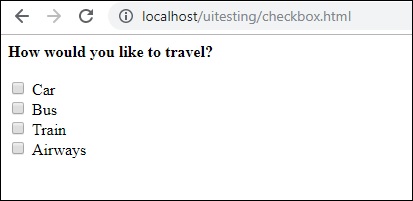
Now, let us use Watir to locate the checkbox in browser as shown below −
require 'watir'
b = Watir::Browser.new
b.goto('http://localhost/uitesting/checkbox.html')
t = b.checkbox value: 'Train'
t.exists?
t.set
b.screenshot.save 'checkbox.png'
To locate checkbox in the browser, use b.checkbox with value you want to select.
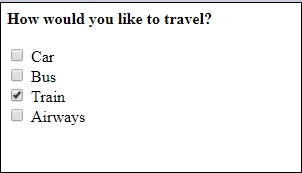
Working with Buttons
Syntax
browser.button(:name => "btnsubmit").click // will get the reference to the button element with has name btnsubmit
Here is the test page for button −
<html>
<head>
<title>Testing UI using Watir</title>
</head>
<body>
<script type = "text/javascript">
function wsclick() {
document.getElementById("buttondisplay").innerHTML = "Button is clicked";
document.getElementById("buttondisplay").style.display = "";
}
</script>
<form name = "myform" method = "POST">
<div>
<br>
<input type = "button" id = "btnsubmit" name = "btnsubmit"
value = "submit" onclick = "wsclick()"/>
<br>
</div>
</form>
<br/>
<div style = "display:none;" id = "buttondisplay"></div>
</body>
</html>
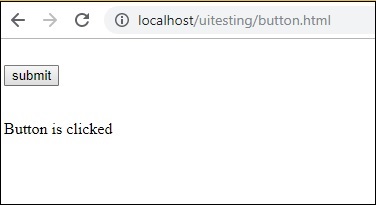
Here is watir code to locate the button on the given page −
require 'watir'
b = Watir::Browser.new
b.goto('http://localhost/uitesting/button.html')
b.button(:name => "btnsubmit").click
b.screenshot.save 'button.png'
Here is the screenshot button.png

Working with Links
Syntax
browser.link text: 'Click Here' // will get the reference to the a tag with text Click Here
We are going to use the following test page to test links −
<html>
<head>
<title>Testing UI using Watir</title>
</head>
<body>
<br/>
<br/>
<a href = "https://www.google.com">Click Here</a>
<br/>
</body>
</html>
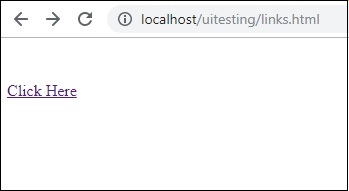
The Watir details required to test links are as given below −
require 'watir'
b = Watir::Browser.new
b.goto('http://localhost/uitesting/links.html')
l = b.link text: 'Click Here'
l.click
b.screenshot.save 'links.png'
Output

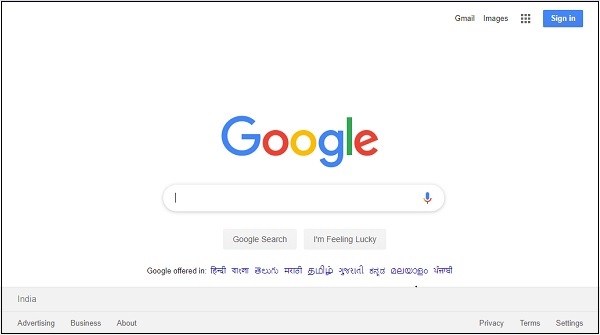
Working with Divs
Syntax
browser.div class: 'divtag' // will get the reference to div with class divtag
Test page where we can test for div.
<html>
<head>
<title>Testing UI using Watir</title>
<style>
.divtag {
color: blue;
font-size: 25px;
}
</style>
</head>
<body>
<br/>
<br/>
<div class = "divtag"> UI Testing using Watir </div>
<br/>
</body>
</html>
Output
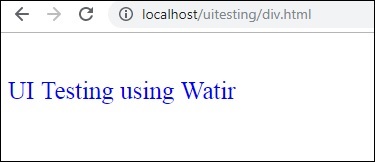
The Watir code to test the div is shown here −
require 'watir'
b = Watir::Browser.new
b.goto('http://localhost/uitesting/div.html')
l = b.div class: 'divtag'
l.exists?
l.text
b.screenshot.save 'divtag.png'
Output
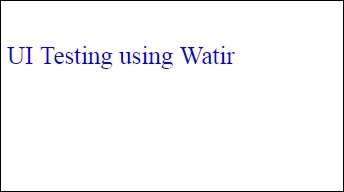
Watir - Locating Web Elements
In Watir for testing, you need to locate the elements and it can be done in different ways by using the id, class or text of the element.
In this chapter, we will see few examples which shows different ways to locate elements.
Using ID of the Element
Test page
<html>
<head>
<title>Testing UI using Watir</title>
</head>
<body>
<script type = "text/javascript">
function wsentered() {
console.log("inside wsentered");
var firstname = document.getElementById("firstname");
if (firstname.value != "") {
document.getElementById("displayfirstname").innerHTML =
"The name entered is : " + firstname.value;
document.getElementById("displayfirstname").style.display = "";
}
}
</script>
<div id = "divfirstname">
Enter First Name :
<input type = "text" id = "firstname" name = "firstname" onchange = "wsentered()" />
</div>
<br/>
<br/>
<div style = "display:none;" id = "displayfirstname">
</div>
</body>
</html>
Example
require 'watir'
b = Watir::Browser.new :chrome
b.goto('http://localhost/uitesting/textbox.html')
t = b.text_field(id: 'firstname') // using the id of the textbox to locate the textbox
t.exists?
t.set 'Riya Kapoor'
b.screenshot.save 'textboxbefore.png'
t.value
t.fire_event('onchange')
b.screenshot.save 'textboxafter.png'
In this example, we are using id of the textbox element to locate it and set the value.
t = b.text_field(id: 'firstname')
Output

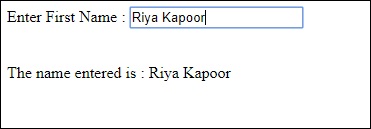
In case you need to locate the div, span or any other html tag you can do same using id as follows −
For div
browser.div(id: "divid") browser.div(id: /divid/)
For span
browser.span(id: "spanid") browser.span(id: /spanid/)
Using NAME of the Element
Test page
<html>
<head>
<title>Testing UI using Watir</title>
</head>
<body>
<script type = "text/javascript">
function wsentered() {
console.log("inside wsentered");
var firstname = document.getElementById("firstname");
if (firstname.value != "") {
document.getElementById("displayfirstname").innerHTML =
"The name entered is : " + firstname.value;
document.getElementById("displayfirstname").style.display = "";
}
}
</script>
<div id = "divfirstname">
Enter First Name :
<input type = "text" id = "firstname" name = "firstname" onchange = "wsentered()" />
</div>
<br/>
<br/>
<div style = "display:none;" id = "displayfirstname">
</div>
</body>
</html>
Example
require 'watir'
b = Watir::Browser.new :chrome
b.goto('http://localhost/uitesting/textbox.html')
t = b.text_field(name: 'firstname') // name is used to locate the textbox element
t.exists?
t.set 'Riya Kapoor'
b.screenshot.save 'textboxbefore.png'
t.value
t.fire_event('onchange')
b.screenshot.save 'textboxafter.png'
Output


Using Tag Name
You can locate any html elements you want by directly using the html tag as shown below.
For div
browser.div(id: "divid") browser.div(id: /divid/)
For span
browser.span(id: "spanid") browser.span(id: /spanid/)
For p tag
browser.p(id: "ptag") browser.p(id: /ptag/)
For button
browser.button(id: "btnid") browser.button(id: /btnid/)
Using Class Name
You can locate the element using its classname. It can be done as shown below −
For div
browser.div(class: "divclassname") browser.div(class: /divclassname/)
For span
browser.span(class: "spanclassname) browser.span(class: /spanclassname/)
For p tag
browser.p(class: "pclassname") browser.p(class: /pclassname/)
For button
browser.button(class: "btnclassname") browser.button(class: /btnclassname/)
For textbox
browser.text_field(class: 'txtclassname') browser.text_field(class: /txtclassname/)
You can also pass multiple classes as shown below −
For div
browser.div(class: ["class1", "class2"])
Using Text
This is yet another way to locate elements by using elements with a text. For example −
browser.button(text: "button text") browser.button(text: /button text/)
Using Label
You can use the label of the element to locate it as shown below −
browser.text_field(label: "text here")) browser.text_field(label: /text here/))
Using Data Attributes
In-case you have data attributes to your html tags, you can locate the elements using it as shown below −
For example, you can locate the tag as shown below −
<div data-type = "test1"></div>
You can locate the div as follows −
browser.div(data-type: 'test1')) browser.div(data-type: /test1/))
Using Custom Attributes
You can also locate the elements using custom attributes as shown below −
Example of html element
<div itemprop = content> . </div>
You can locate the div as follows −
browser.div(itemprop: content')) browser.div(itemprop: /content/))
Using Visible Attribute
The element using visible attribute can be located as shown below −
browser.div(visible: true) browser.div(visible: false)
Watir - Working with Iframes
Watir offer easy to use syntax to work with iframes.
Syntax
browser.iframe(id: 'myiframe') // will get the reference of the iframe where we want to input details.
To understand how to deal with iframes and locate the elements inside an iframe, in this chapter, we will work on an example.
Example
main.html
<html>
<head>
<title>Testing using Watir</title>
</head>
<body>
<iframe src = "test1.html" id = "myiframe" width = "500" height = "100"></iframe>
</body>
</html>
test1.html
<html>
<head>
<title>Testing UI using Watir</title>
</head>
<body>
<script type = "text/javascript">
function wsentered() {
console.log("inside wsentered");
var firstname = document.getElementById("firstname");
if (firstname.value != "") {
document.getElementById("displayfirstname").innerHTML =
"The name entered is : " + firstname.value;
document.getElementById("displayfirstname").style.display = "";
}
}
</script>
<div id = "divfirstname">
Enter First Name :
<input type = "text" id = "firstname" name = "firstname" onchange = "wsentered()" />
</div>
<br/>
<br/>
<div style = "display:none;" id = "displayfirstname"></div>
</body>
</html>
Output
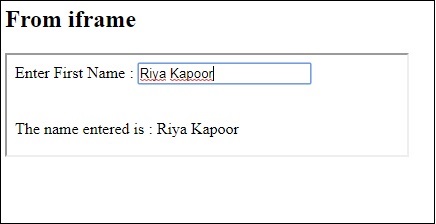
In the above example, the entry form is defined inside an iframe. The Watir code which will help us to locate it and test the form is given below −
Watir Code
require 'watir'
b = Watir::Browser.new :chrome
b.goto('http://localhost/uitesting/main.html')
t = b.iframe(id: 'myiframe').text_field
t.set 'Riya Kapoor'
b.screenshot.save 'iframetestbefore.png'
t.fire_event('onchange')
b.screenshot.save 'iframetestafter.png'
Watir code to locate the iframe in the url given here −
t = b.iframe(id: 'myiframe').text_field
We have used the tag name iframe and the id of the iframe as shown above.
The screenshots of the above code are shown below −
iframetestbefore.png

iframetestafter.png

Watir - Automatic Waits
In this chapter, let us understand waits in detail. To understand automatic waits, we have created a simple test page. When user enters text in the textbox onchange event is fired and after 3-seconds the button is enabled.
Watir has a wait_unit api call which waits on a particular event or property. We will test the same for the test page as given below −
Syntax
browser.button(id: 'btnsubmit').wait_until(&:enabled?) //here the wait is on the button with id : btnsubmit to be enabled.
testwait.html
<html>
<head>
<title>Testing UI using Watir</title>
</head>
<body>
<script type = "text/javascript">
function wsentered() {
setTimeout(function() {
document.getElementById("btnsubmit").disabled = false; }, 3000);
}
function wsformsubmitted() {
document.getElementById("showmessage").style.display = "";
}
</script>
<div id = "divfirstname">
Enter First Name :
<input type = "text" id = "firstname" name = "firstname" onchange = "wsentered()" />
</div>
<br/>
<br/>
<button id = "btnsubmit" disabled onclick = "wsformsubmitted();">Submit</button>
<br/<
<br/<
<div id = "showmessage" style = "display:none;color:green;font-size:25px;">l;
Button is clicked
</div>
</body>
</html>
Output
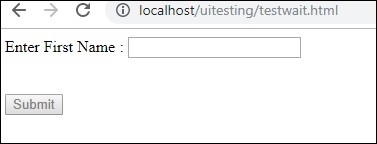
When you enter the text in the textbox, you will have to wait for 3 seconds for the button to be enabled.
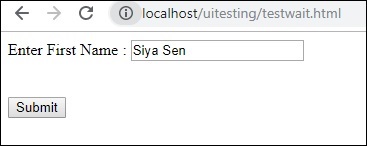
When you click the Submit button, the following text is displayed −
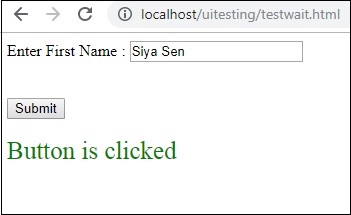
Now since we have added delay for the button to be enabled, it is difficult for the automation to handle such cases. Whenever we have some delay or have to wait on some event or property of the element to be located, we can make use of wait_until as shown below −
Watir code using wait_until
require 'watir'
b = Watir::Browser.new :chrome
b.goto('http://localhost/uitesting/testwait.html')
t = b.text_field(name: 'firstname')
t.exists?
t.set 'Riya Kapoor'
b.screenshot.save 'waittestbefore.png'
t.value
t.fire_event('onchange')
btn = b.button(id: 'btnsubmit').wait_until(&:enabled?)
btn.fire_event('onclick');
b.screenshot.save 'waittestafter.png'
Next, use the following command
btn = b.button(id: 'btnsubmit').wait_until(&:enabled?)
Watir is going to wait for the button to get enabled and later go for click event to be fired. The screenshots captured are shown below −
Waittestbefore.png
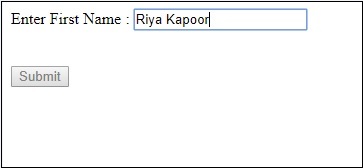
waittestafter.png
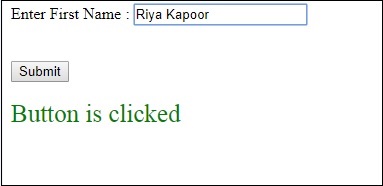
Watir - Headless Testing
In this chapter, we will learn how to use headless option of the Watir webdriver to test the page url.
Syntax
Browser = Watir::Browser.new :chrome, headless: true
The test page that we are going to test is shown here −
<html>
<head>
<title>Testing UI using Watir</title>
</head>
<body>
<script type = "text/javascript">
function wsentered() {
console.log("inside wsentered");
var firstname = document.getElementById("firstname");
if (firstname.value != "") {
document.getElementById("displayfirstname").innerHTML =
"The name entered is : " + firstname.value;
document.getElementById("displayfirstname").style.display = "";
}
}
</script>
<div id = "divfirstname">
Enter First Name : <input type = "text" id = "firstname" name = "firstname" onchange = "wsentered()" />
</div>
<br/>
<br/>
<div style = "display:none;" id = "displayfirstname"></div>
</body>
</html>
Output

Watir code
require 'watir'
b = Watir::Browser.new :chrome, headless: true
b.goto('http://localhost/uitesting/textbox.html')
t = b.text_field(name: 'firstname')
t.exists?
t.set 'Riya Kapoor'
t.value
t.fire_event('onchange')
b.screenshot.save 'headless.png'
We have added the option headless : true to the Watir chrome browser. When you execute the Ruby program, it will not open the browser, everything will get executed in the command line −
DevTools listening on ws://127.0.0.1:53973/devtools/browser/b4127866-afb8-4c74-b967-5bacb3354b19 [0505/144843.905:INFO:CONSOLE(8)] "inside wsentered", source: http://localhost/uitesting/textbox.html (8)
We have added console.log message and the same in printed in command line.
The screenshot of headless.png is shown below −

In Firefox
The watir code for Firefox is shown here −
require 'watir'
b = Watir::Browser.new :firefox, headless: true
b.goto('http://localhost/uitesting/textbox.html')
t = b.text_field(name: 'firstname')
t.exists?
t.set 'Riya Kapoor'
t.value
t.fire_event('onchange')
b.screenshot.save 'headlessfirefox.png'
The screenshot for headlessfirefox.png is shown here −

Watir - Mobile Testing
For Mobile testing, we are going to use Desktop browser which will act as device browser for testing purpose. Let us understand its procedure in this chapter.
To test your app on mobile browsers we need to install the webdriver-user-agent.
Installing webdriver-user-agent
gem install webdriver-user-agent
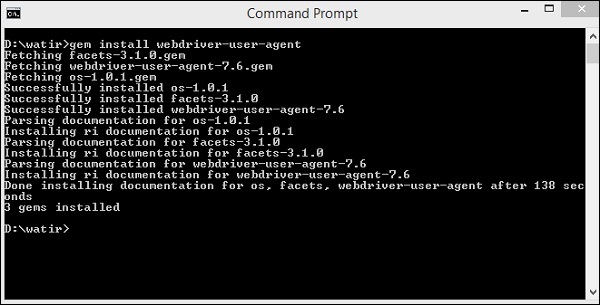
Now, we are going to use the Webdriver useragent as shown in the example below −
Example
require 'watir'
require 'webdriver-user-agent'
driver = Webdriver::UserAgent.driver(browser: :chrome, agent: :iphone, orientation: :landscape)
browser = Watir::Browser.new driver
browser.goto 'https://facebook.com'
puts "#{browser.url}"
puts browser.url == 'https://m.facebook.com/'
We have given facebook.com url. When you execute it, it opens up in the mobile mode, based on the useragent, as shown below −
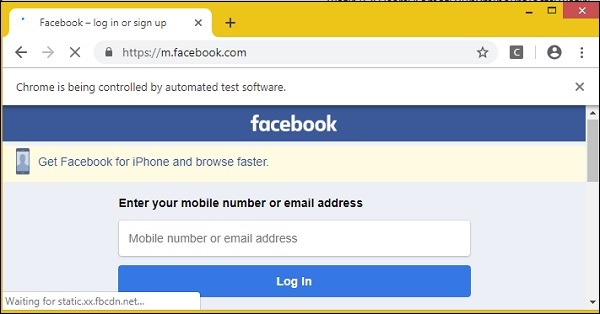
Let us now try in portrait mode. Use the following code for this purpose −
require 'watir'
require 'webdriver-user-agent'
driver = Webdriver::UserAgent.driver(browser: :chrome, agent: :iphone, orientation: :portrait)
browser = Watir::Browser.new driver
browser.goto 'https://facebook.com'
puts "#{browser.url}"
puts browser.url == 'https://m.facebook.com/'
The output in the portrait mode is as shown below −
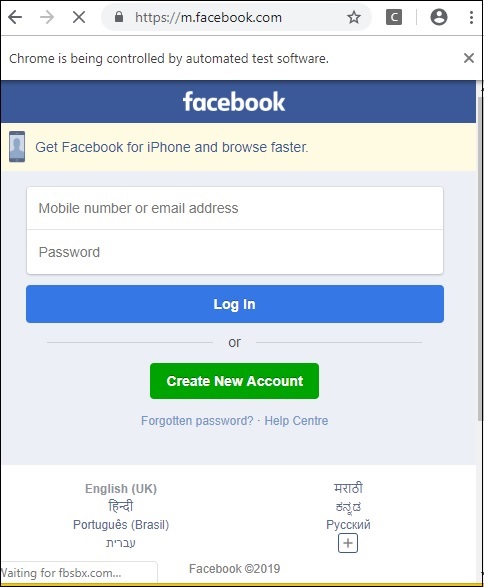
Watir - Capturing Screenshots
Ability to capture screenshots is one of the interesting features available with Watir. During the test automation, you can take screenshots and save the screens. In case, if any error occurs the same can be documented with the help of screenshot.
A simple example along with test page where we have taken the screenshot is discussed below −
Syntax
browser.screenshot.save 'nameofimage.png'
Test page
<html>
<head>
<title>Testing UI using Watir</title>
</head>
<body>
<script type = "text/javascript">
function wsentered() {
console.log("inside wsentered");
var firstname = document.getElementById("firstname");
if (firstname.value != "") {
document.getElementById("displayfirstname").innerHTML =
"The name entered is : " + firstname.value;
document.getElementById("displayfirstname").style.display = "";
}
}
</script>
<div id = "divfirstname">
Enter First Name :
<input type = "text" id = "firstname" name = "firstname" onchange = "wsentered()" />
</div>
<br/>
<br/>
<div style = "display:none;" id = "displayfirstname"></div>
</body>
</html>
Example
require 'watir'
b = Watir::Browser.new :chrome
b.goto('http://localhost/uitesting/textbox.html')
t = b.text_field(id: 'firstname') // using the id of the textbox to locate the textbox
t.exists?
t.set 'Riya Kapoor'
b.screenshot.save 'textboxbefore.png'
t.value
t.fire_event('onchange')
b.screenshot.save 'textboxafter.png'
The screenshots we have taken using Watir are shown here −
textboxbefore.png

textboxafter.png

Watir - Page Objects
Page Object in Watir helps us to reuse the code in the form of classes. Using the page object feature, we can automate our app without having to duplicate any code and also makes the code manageable.
When testing, we can create page object for each of the page we are going to test. Then, we are going to access the methods and properties using the page object.
The reasons behind using page object −
In case any changes are done to the page at alter changes, re-writing the code is not needed.
To avoid code redundancy.
We are going to use RSpec to make use of page-object in Watir. Incase if you are not familiar with RSpec, here is a full tutorial available for RSpec for you learning.
The page that we are going to perform test on is given here −
textbox.html
<html>
<head>
<title>Testing UI using Watir</title>
</head>
<body>
<script type = "text/javascript">
function wsentered() {
console.log("inside wsentered");
var firstname = document.getElementById("firstname");
if (firstname.value != "") {
document.getElementById("displayfirstname").innerHTML =
"The name entered is : " + firstname.value;
document.getElementById("displayfirstname").style.display = "";
}
}
</script>
<div id = "divfirstname">
Enter First Name :
<input type = "text" id = "firstname" name = "firstname" onchange = "wsentered()" />
</div>
<br/>
<br/>
<div style = "display:none;" id = "displayfirstname"></div>
</body>
</html>
Output

We will now create page object for the above page as shown below −
pageobjecttest.rb
class InitializeBrowser
def initialize(browser)
@browser = browser
end
end
class TestPage lt; InitializeBrowser
def textbox
@textbox = TestTextbox.new(@browser)
end
def close
@browser.screenshot.save 'usingpageobject.png'
@browser.close
end
end # TestPage
class TestTextbox < InitializeBrowser
URL = "http://localhost/uitesting/textbox.html"
def open
@browser.goto URL
self
end
def enterdata_as(name)
name_field.set name
name_field.fire_event('onchange')
end
private
def name_field
@browser.text_field(:id > "firstname")
end
end # TestTextbox
There are three classes defined - InitializeBrowser, TestPage and TestTextbox −
InitializeBrowser − This will initialize the browser opened and share the browser object with TestPage and TestTextbox classes.
TestPage − This class will have object reference to TestTextbox and contains the method to capture screenshot and close the browser.
TestTextbox − This class will have methods to open the page url, give reference to textfield, set the data and fire onchange event.
Once you execute the code shown above, you can see the output as shown below −

Watir - Page Performance
Watir Page performance feature allows you to track the response time metrics and it works fine in Chrome, Firefox, IE9 and above. Safari browser does not have the support as of now.
Let us take a closer look on how to use this feature. To make use of it, we need to install watir-performance using gem as shown below −
Command
gem install watir-performance
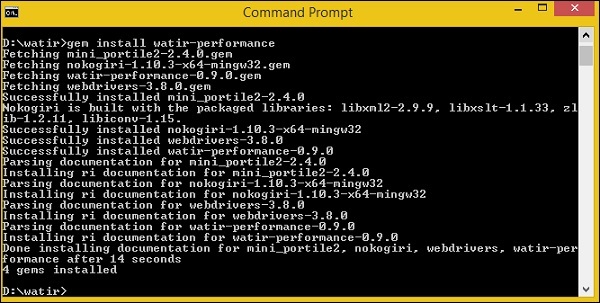
We are done with installing watir-performance. The metrics that are supported are −
- summary
- navigation
- memory
- Timing
A working example using watir-performance is discussed here. Here, we will check the response time for site − www.tutorialspoint.com as shown below −
require 'watir'
require 'watir-performance'
10.times do
b = Watir::Browser.new :chrome
b.goto 'https://www.tutorialspoint.com'
load_secs = b.performance.summary[:response_time] / 1000
puts "Load Time: #{load_secs} seconds."
b.close
end
output
Load Time: 7 seconds. Load Time: 7 seconds. Load Time: 5 seconds. Load Time: 5 seconds. Load Time: 6 seconds. Load Time: 5 seconds. Load Time: 5 seconds. Load Time: 13 seconds. Load Time: 12 seconds. Load Time: 5 seconds.
Using performance.timing
require 'watir'
require 'watir-performance'
b = Watir::Browser.new :chrome
b.goto 'https://www.tutorialspoint.com'
load_secs = b.performance.timing[:response_end] - b.performance.timing[:response_start]
puts "Time taken to respond is #{load_secs} seconds."
b.close
output
Time taken to respond is 41 seconds.
Using performance.navigation
require 'watir'
require 'watir-performance'
b = Watir::Browser.new :chrome
b.goto 'https://www.tutorialspoint.com'
perf_nav = b.performance.navigation
puts "#{perf_nav}"
b.close
output
{:type_back_forward=>2, :type_navigate=>0, :type_reload=>1,
:type_reserved=>255, :redirect_count=>0, :to_json=>{}, :type=>0}
Using performance.memory
require 'watir'
require 'watir-performance'
b = Watir::Browser.new :chrome
b.goto 'https://www.tutorialspoint.com'
memory_used = b.performance.memory
puts "#{memory_used}"
b.close
output
{:js_heap_size_limit=>2, :type_navigate=>0, :type_reload=>1, :ty2136997888,
:total_js_heap_size=>2, :type_navigate=>0, :type_reload=>1, :ty12990756,
:used_js_heap_size=>2, :type_navigate=>0, :type_reload=>1, :ty7127092}
Watir - Cookies
In this chapter, we will learn how to work with cookies using Watir.
A simple example that will fetch the cookies for a URL given is discussed here.
Syntax to fetch cookies
browser.cookies.to_a
Example
require 'watir' b = Watir::Browser.new :chrome b.goto 'https://www.tutorialspoint.com' puts b.cookies.to_a
Output
{:name=>"_gat_gtag_UA_232293_6", :value=>"1", :path=>"/",
:domain=>".tutorialspoint.com", :expires=>2019-05-03 08:33:58 +0000,
:secure=>false}
{:name=>"_gid", :value=> "GA1.2.282573155.1556872379", :path=>"/",
:domain=>".tutorialspoint.com", :expires=>2019-05-04 08:32:57 +0000,
:secure=>false}
{:name=>"_ga", :value=>"GA1.2.2087825339.1556872379", :path=>"/",
:domain=>".tutorialspoint.com", :expires=>
2021-05-02 08:32:57 +0000, :secure=>false}
Now let us add cookies as shown below −
Syntax to add cookies
browser.cookies.add 'cookiename', 'cookievalue', path: '/', expires: (Time.now + 10000), secure: true
Example
require 'watir' b = Watir::Browser.new :chrome b.goto 'https://www.tutorialspoint.com' puts b.cookies.to_a b.cookies.add 'cookie1', 'testing_cookie', path: '/', expires: (Time.now + 10000), secure: true puts b.cookies.to_a
Output Before Adding cookie
{:name=>"_gat_gtag_UA_232293_6", :value=>"1", :path=>"/",
:domain=>".tutorialspoint.com", :expires=>2019-05-03 08:44:23 +0000,
:secure=>false}
{:name=>"_gid", :value=>"GA1.2.1541488984.1556873004",
:path=>"/", :domain=>".tutorialspoint.com",
:expires=>2019-05-04 08:43:24 +0000, :secure=>false}
{:name=>"_ga", :value=>"GA1.2.1236163943.1556873004",
:path=>"/", :domain=>".tutorialspoint.com",
:expires=>2021-05-02 08:43:24 +0000, :secure=>false}
Output After adding cookie
{:name=>"_gat_gtag_UA_232293_6", :value=>"1", :path=>"/",
:domain=>".tutorialspoint.com", :expires=>2019-05-03 08:44:23 +0000,
:secure=>false}
{:name=>"_gid", :value=>"GA1.2.1541488984.1556873004",
:path=>"/", :domain=>".tutorialspoint.com",
:expires=>2019-05-04 08:43:24 +0000, :secure=>false}
{:name=>"_ga", :value=>"GA1.2.1236163943.1556873004",
:path=>"/", :domain=>".tutorialspoint.com",
:expires=>2021-05-02 08:43:24 +0000, :secure=>false}
{:name=>"cookie1", :value=>"testing_cookie", :path=>"/",
:domain=>"www.tutorialspoint.com", :expires=>2039-04-28 08:43:35 +0000,
:secure=>true}
Note that the last one is the one we added using watir.
Clear Cookies
Syntax
browser.cookies.clear
Example
require 'watir' b = Watir::Browser.new :chrome b.goto 'https://www.tutorialspoint.com' puts b.cookies.to_a b.cookies.clear puts b.cookies.to_a
Output
{:name=>"_gat_gtag_UA_232293_6", :value=>"1", :path=>"/",
:domain=>".tutorialspoint.com", :expires=>2019-05-03 08:48:29 +0000,
:secure=>false}
{:name=>"_gid", :value=>"GA1.2.1264249563.1556873251",
:path=>"/", :domain=>".tutorialspoint.com",
:expires=>2019-05-04 08:47:30 +0000, :secure=>false}
{:name=>"_ga", :value=>"GA1.2.1001488637.1556873251",
:path=>"/", :domain=>".tutorialspoint.com",
:expires=>2021-05-02 08:47:30 +0000, :secure=>false
Empty response ie a blank line will get printed after cookie.clear is called.
Delete a particular cookie
Syntax
browser.cookies.delete 'nameofthecookie'
Example
require 'watir' b = Watir::Browser.new :chrome b.goto 'https://www.tutorialspoint.com' puts b.cookies.to_a puts b.cookies.delete "_ga" puts b.cookies.to_a
Output
All cookies:
{:name=>"_gat_gtag_UA_232293_6", :value=>"1", :path=>"/",
:domain=>".tutorialspoint.com", :expires=>2019-05-03 08:52:38 +0000,
:secure=>false}
{:name=>"_gid", :value=>"GA1.2.1385195240.1556873499",
:path=>"/", :domain=>".tutorialspoint.com",
:expires=>2019-05-04 08:51:37 +0000, :secure=>false}
{:name=>"_ga", :value=>"GA1.2.1383421835.1556873499",
:path=>"/", :domain=>".tutorialspoint.com",
:expires=>2021-05-02 08:51:37 +0000, :secure=>false}
After delete cookie with name _ga
{:name=>"_gat_gtag_UA_232293_6",
:value=>"1", :path=>"/", :domain=>".tutorialspoint.com",
:expires=>2019-05-03 08:52:38 +0000, :secure=>false}
{:name=>"_gid", :value=>"GA1.2.1385195240.1556873499",
:path=>"/", :domain=>".tutorialspoint.com",
:expires=>2019-05-04 08:51:37 +0000, :secure=>false}
Watir - Proxies
Watir allows to use proxy with the help of proxy object which needs to be used with the browser.
Syntax
proxy = {
http: '127.0.0.1:8080',
ssl: '127.0.0.1:8080'
}
b = Watir::Browser.new :chrome, proxy: proxy
An example on how to use proxy with Chrome browser is shown below −
Example
require "watir"
proxy = {
http: '127.0.0.1:8080',
ssl: '127.0.0.1:8080'
}
b = Watir::Browser.new :chrome, proxy: proxy
b.goto 'google.com'
b.screenshot.save 'proxy.png'
We have used proxy object as shown below −
proxy = {
http: '127.0.0.1:8080',
ssl: '127.0.0.1:8080'
}
The proxy address details are to be used for both http and ssl. We can use proxy with chrome browser as shown below −
b = Watir::Browser.new :chrome, proxy: proxy
The output proxy.png is shown below −
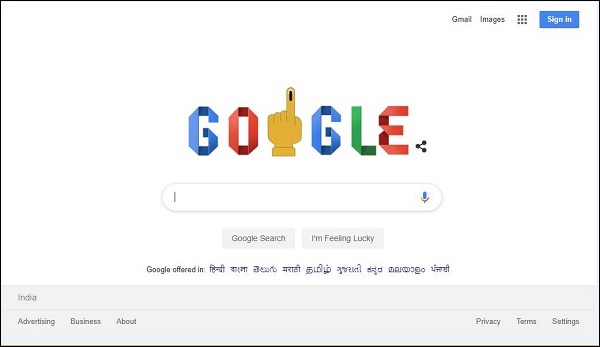
An example on how to use proxy with Firefox browser is discussed below −
Example
require "watir"
proxy = {
http: '127.0.0.1:8080',
ssl: '127.0.0.1:8080'
}
b = Watir::Browser.new :firefox, proxy: proxy
b.goto 'google.com'
b.screenshot.save 'proxyfirefox.png'
You can add the proxy details as shown below −
proxy = {
http: '127.0.0.1:8080',
ssl: '127.0.0.1:8080'
}
b = Watir::Browser.new :firefox, proxy: proxy
The output proxyfirefox.png is shown here −

Watir - Alerts
In this chapter we will understand how to handle alerts using Watir.
Syntax
browser.alert.exists? browser.alert.ok browser.alert.close
Testpage
<html>
<head>
<title>Testing Alerts Using Watir</title>
</head>
<body>
<script type = "text/javascript">
function wsformsubmitted() {
alert("Button is Clicked !");
}
</script>
<button id = "btnsubmit" onclick = "wsformsubmitted();">Submit</button>
</body>
</html>
Watir Code
require 'watir'
b = Watir::Browser.new :chrome
b.goto('http://localhost/uitesting/testalert.html')
b.button(id: 'btnsubmit').click
b.alert.ok
b.screenshot.save 'alerttest.png'
The output alerttest.png is shown here −

Watir - Downloads
We have buttons or links in the UI or our website which downloads a pdf, or a doc. We can test that for using with Watir by giving some preferences to the browser.
The syntax for downloading −
prefs = {
'download' => {
'default_directory' => "C:/download",
'prompt_for_download' => false,
}
}
b = Watir::Browser.new :chrome, options: {prefs: prefs}
The prefs has download wherein we need to give the path where we want the file to be stored after download and the same has to be given to the browsers using options as shown in the syntax above.
A working example is shown here. Here, we have created test page with a button, which when clicked will download a file called file.txt as shown below −
<html>
<head>
<title>Testing UI using Watir</title>
</head>
<body>
<br/>
<br/>
<button id = "btnsubmit">
<a href = "file.txt" download>Click to Download!</a>
</button>
<br/>
</body>
</html>
file.txt
This is for testing watir download
Output
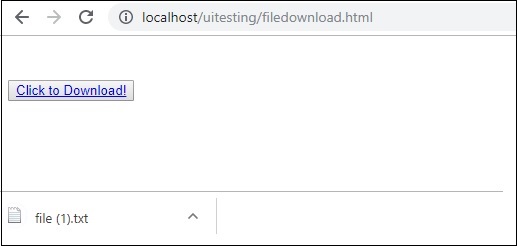
When you click the download button, the file is downloaded.
Now let us test the same using Watir −
require 'watir'
prefs = {
'download' => {
'default_directory' => "C:/download",
'prompt_for_download' => false,
}
}
b = Watir::Browser.new :chrome, options: {prefs: prefs}
b.goto('http://localhost/uitesting/filedownload.html')
b.button(id: 'btnsubmit').click
b.screenshot.save 'testdownload.png'
The path we have given to store the downloaded file is "C:/download". When we execute above code we will have the file download in download path given as shown below −

The output testdownload.png is as shown here −

Watir - Browser Windows
You will come across cases where we have to use popup window or opening of a new browser window. In this chapter, we will discuss how to test such cases using Watir.
Syntax
browser.window
A working example that we are going to test is given here −
<html>
<head>
<title>Testing UI using Watir</title>
</head>
<body>
<script type = "text/javascript">
function wsclick() {
var myWindow = window.open(
"https://www.google.com/", "mywindow", "width = 1000,height = 500");
}
</script>
<form name = "myform" method = "POST">
<div>
<br>
<input type = "button" id = "btnsubmit" name = "btnsubmit" value = "submit" onclick = "wsclick()"/>
<br>
</div>
</form>
<br/>
</body>
</html>
Output
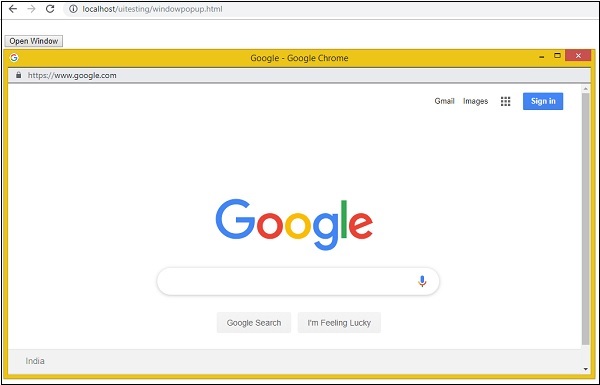
On-click of button Open Window, the popup window opens up. Here, the url we have given is www.google.com. Now let us test the same using Watir/
Example
require 'watir'
b = Watir::Browser.new :chrome
b.goto('http://localhost/uitesting/windowpopup.html')
b.button(id: 'btnsubmit').click
b.window(title: 'Google').use do
b.screenshot.save 'popupwindow.png'
t = b.text_field(class: 'gLFyf')
t.set 'Watir'
b.screenshot.save 'popupwindowbefore.png'
b.button(name: 'btnK').click
b.screenshot.save 'popupwindowafter.png'
end
The screenshots that we have taken are given below −
popupwindow.png

popupwindowbefore.png
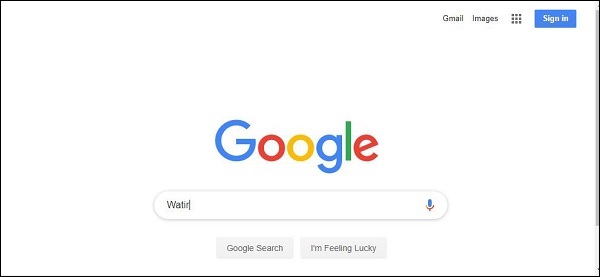
popupwindowafter.png
